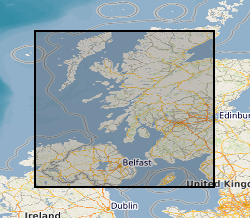Scottish Universities Environmental Research Centre (SUERC)
Type of resources
Topics
Keywords
Contact for the resource
Provided by
Years
Formats
Update frequencies
-

Normalised accelerator mass spectrometry data from beryllium targets prepared using different chemical processes and metal matrices. Filenames include the date the AMS experiments were started. Measurements of 10Be/9Be were made at the SUERC AMS Laboratory using the 15SDH-2 accelerator mass spectrometer with a terminal voltage of 5MV. Measurements of 10Be/9Be nuclide ratios took place between 13/01/2021 and 02/06/2023. Beryllium AMS targets were prepared using the 10Be standard material (Nishiizumi et al., 2010) which were mixed with different metals either as dry powders or as co-precipitates. Targets were loaded into a 134 MC-SNICS sputter ion source to generate negative beryllium oxide beams which were transported through a spherical electrostatic analyser and a 90° magnet before being accelerated to 5MV inside the accelerator. At the 5MV terminal of the accelerator the negative molecular beam passes through a gas stripper which results in removing 4 electrons (stripping) from the negatively charged particles. This results in the breakup of molecules and yields +3 charged atoms. These positively charged atoms are accelerated away from the 5MV terminal and pass through another 90° magnet which separates nuclides on the basis of their mass/charge. Stable 9Be is measured in an offset faraday cup immediately after the second magnet. The extremely rare 10Be was passed through another electrostatic analyser before passing through an absorber cell to eliminate isobaric interference from Boron-10 (10B). Individual 10Be atoms were counted in a gas ionisation detector. Raw AMS data was normalised to NIST SRM 4325. Each sample was measured for more than 100 minutes. The experiments were designed to determine if sample longevity and beam current intensity could be improved with different metal matrices. The rationale is to get higher count rates in the detector. Higher count rates improve the precision of the measurements. Higher precision provides opportunities to address questions related to centennial environmental changes using 10Be surface exposure dating. Dr Ana Carracedo (chemical preparation of AMS targets), Dr Derek Fabel (AMS measurements and data reductions), Dr Richard Shanks (AMS setup).
-

Data collected as part of the NERC funded Radioactivity and the Environment (RATE), Long-lived Radionuclides in the Surface Environment (Lo-RISE), research consortium.This data comes from the marine workstream group based at the Scottish Universities Environmental Research Centre (SUERC) and the Scottish Association for Marine Science (SAMS). The data consists of radionuclide measurements of environmental and biological samples including radiocarbon, caesium (137), americium (241) and plutonium (238, 239, 240).The data has been published in the following publications: Tierney et al., 2018. Modelling Marine Trophic Transfer of Radiocarbon (14C) from a Nuclear Facility. Ecosystem Modelling and Software 102, 138-154. Tierney et al., 2017. Nuclear Reprocessing-Related Radiocarbon (14C) Uptake into UK Marine Mammals. Marine Pollution Bulletin 124, 43-50. Muir et al., 2017. Ecosystem Uptake and Transfer of Sellafield-Derived Radiocarbon (14C). Part 1: The Irish Sea. Marine Pollution Bulletin 114, 792-804. Tierney et al., 2017. Ecosystem Uptake and Transfer of Sellafield-Derived Radiocarbon (14C). Part 2: The West of Scotland. Marine Pollution Bulletin 115, 57-66 Tierney et al., 2016. Accumulation of Sellafield-derived 14C in Irish Sea and West of Scotland Intertidal Shells and Sediments. Journal of Environmental Radioactivity 151, 321-327.
 NERC Data Catalogue Service
NERC Data Catalogue Service